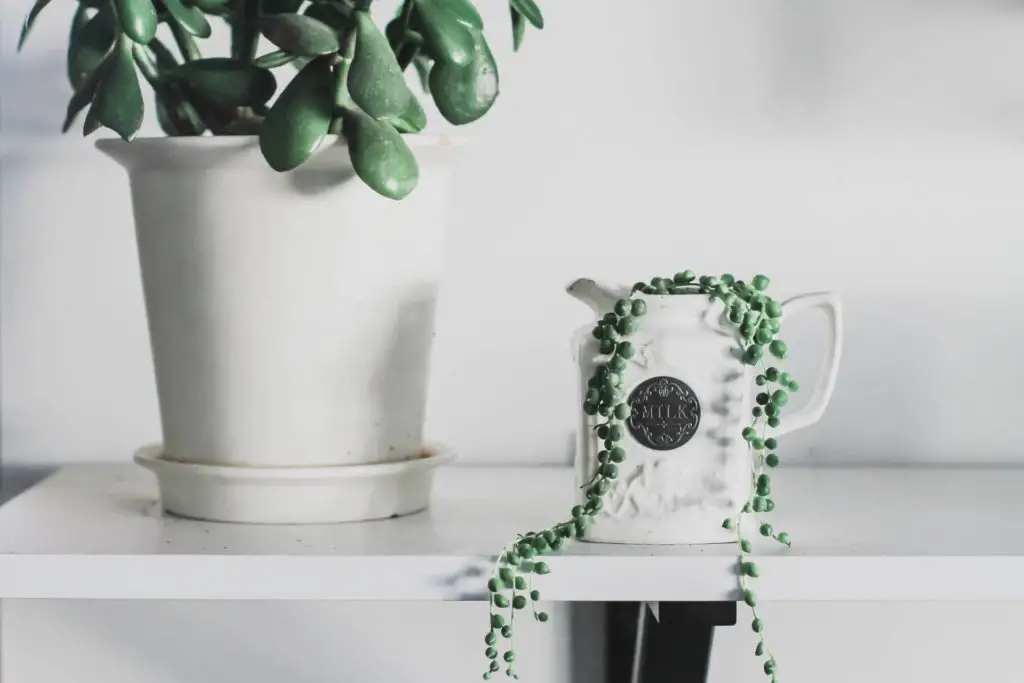Who doesn’t want a string of pearls on his succulents collection! However, owning this plant requires the right watering habits. In this article, I will talk about how to water your string of pearls the right way.
And the right water type to use. Plus the factors that determine how often you should water your string of pearls.
But before diving deep into the details, I will put the answer to our main question as simple as this: how to water a string of pearls? A string of pearls should be watered whenever the soil dries out completely. You can tell whether the soil is dried or not by inserting your finger or dry stick into the drainage hole.
Keep reading to know the factors that determine how often you should water your plant.

Factors affecting how often you should water string of pearls
There is no universal watering schedule that will work for everyone because the following factors differ from one person to another.
Pot size
The bigger the pot that string of pearls potted in the less watering you may apply. Because a bigger pot accommodates much soil. The extra soil will retain more moisture when compared with the smaller pots.
On the other hand, The smaller the planter the more water the plant will need.
Location
Generally speaking, an outdoor string of pearls will need more watering frequency when compared with the indoor ones. Because in the outdoor environment the light, airflow, and evaporation rate are higher.
Season
The string of pearls is a winter grower. That means it actively grows during the spring and fall seasons. Although it will have slow growth during the days when the temperature is very low ( very cold days).
In summer it goes dormant, it focuses on resting and survival more than on growth. Therefore during the growing season ( spring and fall), your plant will consume more water in order to support the growth.
While in summer the plant will need less watering because it doesn’t need much energy.
The right way to water a string of pearls
The concrete approach to follow when watering your string of pearls is to follow the soak and dry method. This method applies that you only water your string of pearls when the soil is completely dry.
And when you do, water deeply until the water drains from the drainage holes. And don’t forget to empty the saucer from the drained water.
You can tell whether the soil dried out completely or not by inserting your finger into the drainage hole. Also, you can use a small stick instead of your finger.
The soak and dry method will work great all year-round. However, In summer only water your plant when the soil is dry and the leaves start to look like a deflated balloon.
Because the string of pearls is prone to root rot caused by overwatering. And don’t worry, your plant will recover from a little drought easily. And it is always better to underwater your string of pearls than to overwater.
In deserts, where a string of pearls belongs. There are less frequent waterfalls. But when it rains, it rains abundantly. So soak and dry method is mimicking the natural habitat of the string of pearls.
Following the soak and dry is great. But it will not work as it should if you plant your string of pearls in a pot without drainage holes. Drainage holes allow the excess water to drain.
Also, you should make sure to use cactus and succulent potting mix for your plant. Because of such a soil is porous enough to allow the water to drain well.
The right water type
Rainwater is great when it comes to watering your string of pearls. You can collect rainwater during the fall season and using it throughout the year.
The second best option to use is distilled water. Avoid using tap water because tap water contains treated chemicals that will build up in the soil through time as salts.
Those salts will make some necessary nutrients unavailable for the plant to absorb. However, if you currently only have access to tap water make sure to treat it before using it.
You treat it by putting the tap water in an open container overnight for some treated chemicals to dissipate in the air.
Can I mist my string of pearls?
A string of pearls doesn’t like high humidity. Therefore misting your string of pearls can do more harm than good. Besides, the plant doesn’t need it.
The water that misted on the leaves may set there for a long period of time which may cause rot. However, a string of pearl cuttings can be misted.
Should you bottom water string of pearls?
Yes, you can water your string of pearls from the bottom. However, it is not necessary. Because the roots of the string of pearls are shallow roots. And the purpose of bottom watering is to make sure that the water gets to the root zone.
If you want to bottom water your string of pearls make sure that the topsoil becomes moist before moving your plant from the water tray.
Sings of an underwatered string of pearls
An underwater string of pearls will have leaves that look like a deflated balloon, and the leaves will look dry and wilting.
In a such case don’t worry your plant will easily recover as long as you give it a good soak and let the soil dries out completely before soaking again.
Signs of an overwatered string of pearls
An overwatered string of pearls will have yellow and transparent leaves. And the stem will turn to black color. And it will feel sticky. In such a case cut back the watering frequency until your plant recover.
How to water string of pearls planted in a pot without drainage holes
I don’t recommend potting your string of pearls in a pot without drainage holes. Because the odds of failure are higher than the odds of success.
However, Some people may still plant their plant in planter without drainage holes for different reasons.
If this is the case, the purpose of watering should be to give the plant amount of water that will give the plant enough moisture without excessive water that will rot the roots through time.
Through trial and error, I found that the amount of water that will accomplish such an equation equals the half soil volume.
For example, if the potting mix fills X container. You should give your string of pearls water that fills half of the X container. Also, there is another method you can apply.
The other method is lifting the plant’s planter regularly and feeling its weight. When the planter no longer gets lighter that means the water dried out completely. Then you can water your plant. For more detailed information and a holistic perspective on caring for potted plants and mastering Container Gardening, Get my book Container Gardening: A Step-by-Step Practical Guide.
